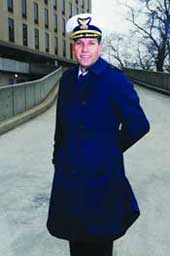Ports of opportunity

Coast Guard vessel tracking project draws in major players.

"We are weighing options and also looking at maintaining integrity while we are moving ahead." ? Capt. Kurtis Guth, U.S. Coast Guard
The Coast Guard's contract for the Nationwide Automatic Identification System for commercial vessels has an appeal far larger than its size would suggest.
The vessel communication system will help the Coast Guard create safer shipping lanes by tracking and communicating the location of commercial vessels. Budgeted at about $11 million this year, the project appears relatively modest in scope.
Nonetheless, a Jan. 18 industry briefing for the system brought out executives from more than dozen of the largest federal contractors, including Boeing Co., General Dynamics Corp., L-3 Communications Inc., Lockheed Martin Corp., Northrop Grumman Corp., Raytheon Co. and Science Applications International Corp.
Executives said the identification system, while still not fully defined, is perceived as a possible gateway to larger Coast Guard projects, especially Command 2010, which will update the agency's major command and control systems. Details of that system have not yet been announced.
"The automatic identification system is being viewed as a steppingstone," said a prospective subcontractor who asked not to be identified. "That is why all the heavy hitters are interested."
The goal is to foster safety through ship collision avoidance and traffic management. The data also will be shared with command and control centers for maritime situational awareness, providing real-time ability to track vessels deemed to be threats, for example.
"The Nationwide Automatic Identification System is one element of maritime domain awareness," Capt. Kurtis Guth, project manager, told Washington Technology.
Although Guth stopped short of calling the program a "gateway," he said it will provide a foundation of basic information for future systems.
The identification system's data will be fed into many other command and control systems and common operating pictures, including those of the Coast Guard, Homeland Security and other federal, state and local partners. Accomplishing this will require creating a service-oriented architecture and linking with other Coast Guard systems, Guth said.
"This information will be share-able from the get-go," he said.
The identification system, deployed as part of the 2002 Maritime Trans-portation Security Act, follows an international protocol set for ship-to-ship, ship-to-shore and shore-to-ship automatic communications regarding such things as vessel identity, position, speed and course. Equipment for participating in the system is required domestically and internationally aboard many commercial vessels. In the future, it may be placed on offshore buoys, platforms and oil rigs as well.
Full maritime situational awareness will require many more elements including radars, sensors and cameras, as well as integration with control centers, Guth said. Building the identification system is a first step in that direction.
Attention-getter
The Coast Guard intends to integrate the system with other ongoing Coast Guard projects, including Rescue 21, which enhances communications along the nation's shorelines, and Integrated Deepwater Systems, the modernization program. Experts also have called for integration with the Secure Border Initiative, a border surveillance system set up by the Customs and Border Protection bureau.
The Coast Guard and Navy handled the first phase of the identification system, under which 55 critical ports will get receive-only capabilities by October. The request for proposals for the second increment is expected this summer, with an award in 2008, Guth said. The contractor must be able to implement the system's architecture. The system must transmit messages for 50 nautical miles and receive messages within 24 nautical miles. It is to be completed by September 2009.
"Increment No. 2 is much more complex," Guth said. "The contractor will need to integrate the system with command and control systems, both for the Coast Guard and the Defense Department." Under a third phase, satellite service will be used to increase transmission range to 2,000 nautical miles.
The program is generating attention, with several dozen people attending last month's industry day.
"There is a lot of interest," said Kay Olive, president of consultancy Olive Group, Arlington, Va. "The real challenge will be in the integration," she said.
"It is an important project, and it appears that the funding is in place," said retired Coast Guard Rear Adm. James Underwood, now with engineering company URS Corp., Gaithersburg, Md. "My sense is that it will help continue to develop overall maritime domain awareness."
But uncertainties about the identification system remain, including overall scope and cost, which has been estimated by industry sources at as much as $165 million.
Several of those at the industry day event raise concerns about technology, including the timing and degree of the integration required; whether there is adequate bandwidth to meet future needs for situational awareness; and whether there are adequate provisions for data storage to handle the requirements for managing and making available for search huge amounts of data.
Procurement Blues
On the procurement side, some are worried about whether the Coast Guard can manage all the integrations needed, given its current difficulties with the $25 billion Deepwater program. Lawmakers last month criticized Deepwater following reports that its centerpiece cutter won't be as robust as expected.
Responding to those concerns, Guth conceded there are some risks with the program but said that it is moving forward on schedule. "We're trying to move ahead as quickly as we can," he said. "We are weighing options and also looking at maintaining integrity while we are moving ahead."
The government will get some help in managing the contract. The Coast Guard has been using the services of Booz Allen Hamilton Inc. to support the acquisition program office. Last month, the support services contract was nearing expiration and has been re-solicited.
"That is the only solicitation that we've put out, and the vendor awarded the contract will provide the NAIS program office support in managing the NAIS acquisition," Guth wrote in an e-mail.
In related news, Guth told Washington Technology he will be involved in the identification system procurement until the summer, when he will be transferred to a position in the department's Secure Border Initiative. The move is a normal Coast Guard job rotation after four years at the acquisition office, he said.
Staff Writer Alice Lipowicz can be reached at alipowicz@postnewsweektech.com.
NEXT STORY: AT&T, Verizon nab California telecom deals